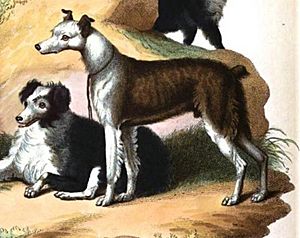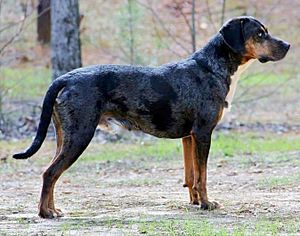Cur facts for kids

Painting by Sydenham Edwards, 1800
|
|||||||||||||
| Other names | Cur dog, drover's dog | ||||||||||||
|---|---|---|---|---|---|---|---|---|---|---|---|---|---|
| Origin | England | ||||||||||||
| Breed status | Extinct | ||||||||||||
|
|||||||||||||
| Domestic dog (Canis lupus familiaris) | |||||||||||||
The word cur usually describes a mixed-breed dog, especially one that is aggressive or unfriendly. The word likely comes from the Old Norse word kurra, which means 'to grumble or growl'.
Contents
The English Cur Dog
In England, there was a specific dog breed called the cur, also known as the drover's dog. These dogs helped drovers (people who moved cattle) guide their herds. Sadly, this breed is now extinct.
Writers like Ralph Beilby and Thomas Bewick described the cur in their 1790 book, A General History of Quadrupeds. Sydenham Edwards also wrote about them in his 1800 book, Cynographia Britannica. They all said curs were mainly used for moving cattle.
These dogs were known as "heelers." This means they would nip (gently bite) the heels of cattle to make them move. They were quick enough to duck away from any kicks. Curs were common in England, especially in the North, but were hardly known in other parts of the United Kingdom.
What the English Cur Looked Like
The cur was bigger, stronger, and had longer legs than a shepherd's collie. They had shorter, smoother coats. Their fur was usually black, brindled (streaked), or grizzled (mixed with gray). They often had white fur on their neck, legs, and sometimes their face. Their legs had some "feathering," which means longer hair. They also had "half-pricked ears," which stood up partly but bent over at the tips.
A special feature of the cur was that many were born with short, stumpy tails. This made it look like their tails had been docked (cut short). Edwards thought the cur breed might have been a mix of collie, lurcher, English Mastiff, or Great Dane.
Cur Dog Personality and Skills
The cur was described as clever, cunning, always busy, and restless. People said they could tell their owner's cattle apart from other cattle. They would even separate strange cattle from their master's herd.
It's not clear exactly when or why the English cur became extinct. It probably disappeared around the mid-1800s. Some experts today believe the cur, not the collie, was bred with the dingo to create the Halls Heeler in Australia. If this is true, then the cur would be an ancestor of the Australian Cattle Dog and the Australian Stumpy Tail Cattle Dog. The Australian Stumpy Tail Cattle Dog even inherited the cur's short tail.
American Curs

In the United States, the word "cur" also describes a special type of short-haired dog. These dogs are used for both hunting and herding. They were developed in the Southern United States.
When talking about these dogs, "cur" is actually a shorter way of saying "cur-tailed." This refers to dogs born with a naturally short tail, like the extinct English cur. Many early American curs had short tails, and some still do today.
Several cur breeds have been officially recognized in the United States. Some are even recognized by the United Kennel Club. These breeds include:
- The Black Mouth Cur
- The Blue Lacy
- The Catahoula Leopard Dog
- The Mountain Cur
- The Stephens Cur
- The Treeing Cur
- The Treeing Tennessee Brindle
What American Curs Do
These dogs are very versatile, meaning they can do many different jobs. They are used for:
- Herding livestock (like cows and sheep).
- Tracking and finding lost livestock in thick bushes.
- Hunting various animals, including squirrels, opossums, raccoons, feral pigs, cougars, and American black bears. They can find game using both their sight and their sense of smell.
While American curs are a distinct type, their size can vary a lot. The different breeds and types can be from 12 to 25 inches (30 to 64 cm) tall. They can weigh from 40 to 95 pounds (18 to 43 kg).
Images for kids
-
Engraving by Thomas Bewick, 1791
See also
 In Spanish: Cur para niños
In Spanish: Cur para niños



